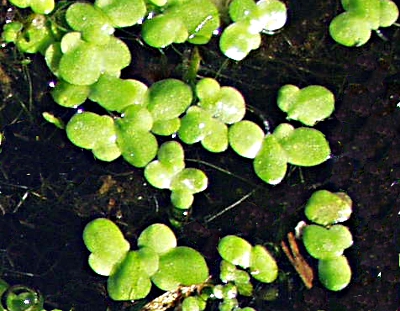Common duckweed |

Fronds of the common duckweed
| Lemna minor L.: | |
| Blooming period: | May–September |
| Fronds: | 2–7 mm long, 1.3–2 times as long as wide |
| Staminate flowers: | 2, very small, each with a single stamen, sepals and petals missing |
| Pistillate flowers: | 1, very small, sepals and petals missing, styles: 1 |
Plant herbaceous, drifting freely in the water, root 1–15 cm long. Forms no winter buds (turions).
Fronds almost symmetrically to strongly asymmetric, flat on both sides, sometimes slightly domed, usually green above, sometimes reddish or with reddish spots, glossy, with usually 3, rarely 5 indistinct veins that reach almost the apex. Plant underneath rarely reddish.Fronds entire, rounded at the base, broadly rounded at the apex, individually or 2–8 fronds contiguous.
Along the centerline small bumps, above the nodes and at the apex with a slightly larger bump.
Lemna minor blooms very rarely. The tiny inflorescence is surrounded by a membranous spathe, which has a narrow opening at the apex and consists of a female flower with an ovary, which consists of a single carpel, and 2 flowers with one stamen. Petals absent.
After pollination by water spiders and water striders a single-seeded, achene-like fruit is formed, which contains an about 1 mm large seed provided with 8–16 longitudinal ribs.
| Floral formula: |
| ♂ * P0 A1 G0 ♀ * P0 A0 G1 |
Occurrence:
Ponds,
small lakes or slow moving water bodies. Prefers highly nutritious,
slightly shaded waters with a pH between 6.5 and 7.5.
Distribution:
Originally
Eurasia, Africa and North America. In Australia, New Zealand, Japan and
South America naturalized.